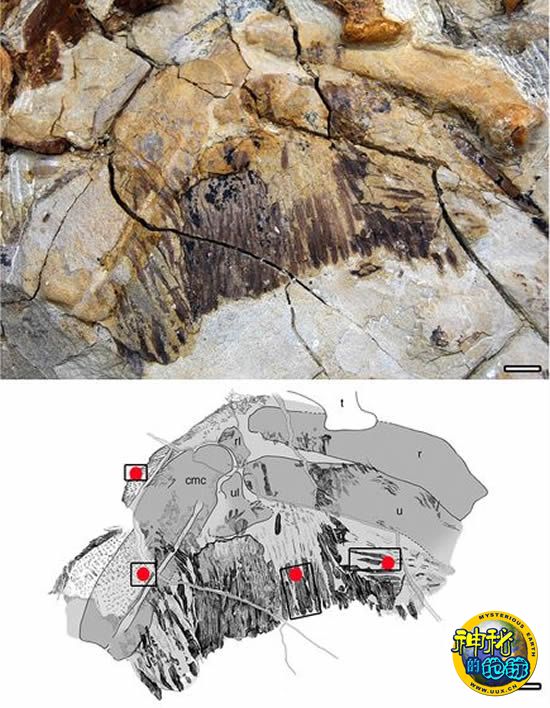Giant Prehistoric Penguin Found, Sported Splashes of Red
An artist's conception suggests one possible design for the water king penguin's gray and reddish plumage.
Splash of Red
In Fine Feather
True Colors
Spreading Their Wings
Penguin Hunting
Ker Than
for National Geographic News
Published September 30, 2010
They don't make penguins like they used to. Thirty-six million years ago, at least one species stood nearly as tall as a man and sported shades of red and gray, scientists announced Thursday.
The new species, called the water king, sheds light on bird evolution, researchers say. For starters, penguins' apparently recent switch to black-and-white may have been more about swimming than, say, sex or camouflage.
Along with at least two other giant prehistoric penguins, the fossil species was discovered in Peru in 2007 but announced only today. Lab researchers recently recovered wing feathers and smaller body feathers from the 5-foot-tall (150-centimeter-tall) penguin species—today's biggest living penguin species, the emperor, is just under 4 feet (120 centimeters) tall.
"We found that the leading edge of its wing was gray, and the underside of the wing was a reddish brown," said study leader Julia Clarke, a paleontologist at the University of Texas at Austin.
But the team doesn't have enough feathers from the water king penguin (Inkayacu paracasensis) to determine the colors of its entire body.
"We can't totally 'color in all the lines' on the penguin yet, or tell which feathers may have been part of a brighter display pattern on the bird, like the eye and neck bands on some modern species of penguin"—such as the rockhopper penguin (picture)—study co-author Dan Ksepka, an avian paleontologist at North Carolina State University, said in a statement.
"But features of the bones tell us that this particular fossil was a fully grown adult, not a juvenile, so finding brown and gray colors was a surprise," he added. (See a picture of a gray emperor penguin chick.)
The team made the discovery when they compared microscopic pigment packets, called melanosomes, in the fossil feathers to melanosomes of modern birds and penguins. Based on the fossil melanosomes' shapes and sizes, the scientists were able to determine the feathers' original colors.
The finding, detailed this week in the journal Science, marks the first time feathers and preserved scales from an ancient penguin have ever been found. It's also the first direct proof scientists have that the distinctive color pattern of living penguins is likely a recent innovation, the authors say.
Black-and-White Swimsuits?
So why did penguins go black-tie?
Perhaps it was a response to the rise of new penguin predators, such as seals, study leader Clarke said. In a phenomenon called countershading, modern penguins' white bellies camouflage the birds against the sky, at least from the vantage point of a swimming predator looking up. To a predator looking down, a penguin's black back vaguely matches the dark depths below.
Then again, the melanosome evidence suggests the tuxedo look might have been a side effect of the birds' increasingly aquatic lifestyle.
The water king's melanosomes had a similar structure and organization as those of living birds that have reddish brown and/or grey feathers, including robins and zebra finches, the team noted. But the fossil pigment packets are very different from those of living penguins, which have larger, rounder melanosomes that are packed together like grape clusters.
It's possible, the team speculates, that the melanosome metamorphosis made penguin feathers stronger—helping transform their wings into stiff, narrow "flippers" for swimming—or conferred some other unknown advantage.
"We're proposing that these shape shifts in penguin melanosomes may not have anything directly to do with color," Clarke said.
Then again, the black-and-white look may have arisen "due to changes in penguin ecology that we haven't figured out yet. We just don't know," added Clarke, who received funding from the National Geographic Society Expeditions Council. (The Society owns National Geographic News.)
Penguin Study Represents "Huge Breakthrough"
The ability to interpret the color of the water king penguin's feathers is "really quite remarkable and represents a huge breakthrough in the study of vertebrate paleontology," said Paul Scofield, curator of vertebrate zoology at New Zealand's Canterbury Museum.
Melanosome analysis had previously revealed the colors of nonflying, feathered dinosaurs. (Pictures: Dinosaur True Colors Revealed by Feather Find.)
But the penguin study proves the technique can be a useful tool when studying fossil birds and other extinct creatures, said Scofield, who was not involved in the study.
To Mike Benton, of the University of Bristol in the U.K., the study is a "superb piece of work."
The paleontologist, who also wasn't part of the new research, said via email that it "shows how paleobiologists now can span the boundary between living and fossil and seek to understand important functional systems, including some like feather coloration, that were hidden to us until recently."

















